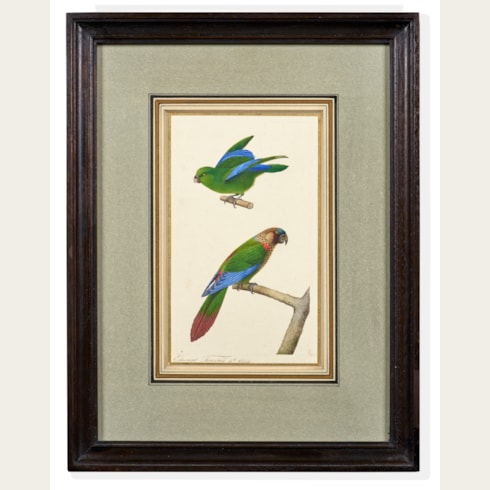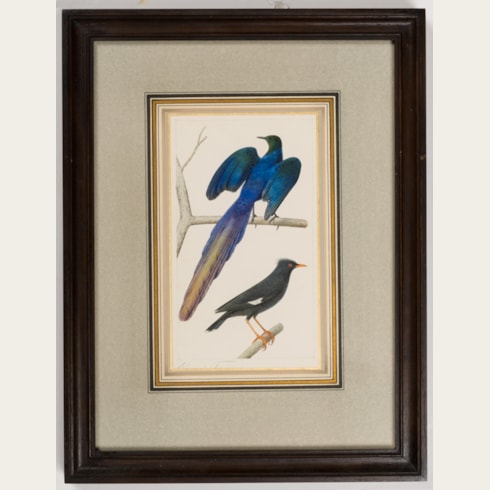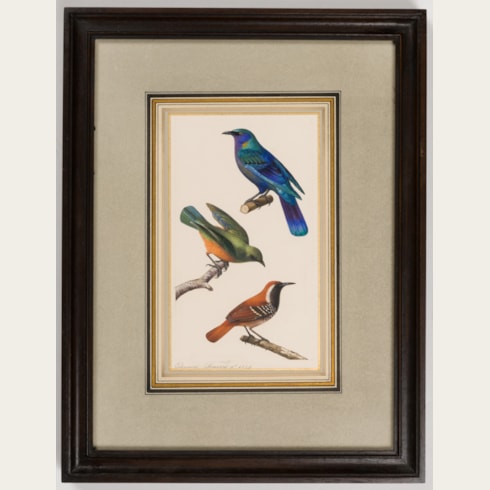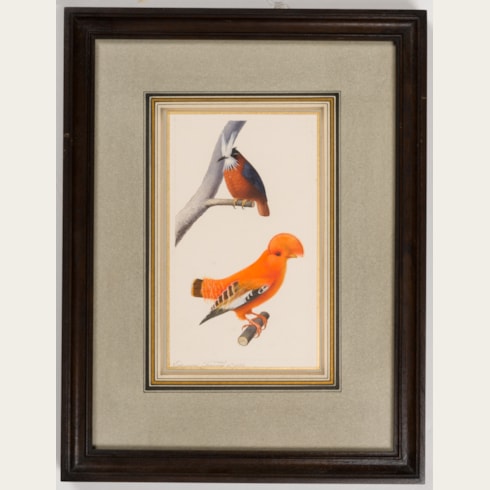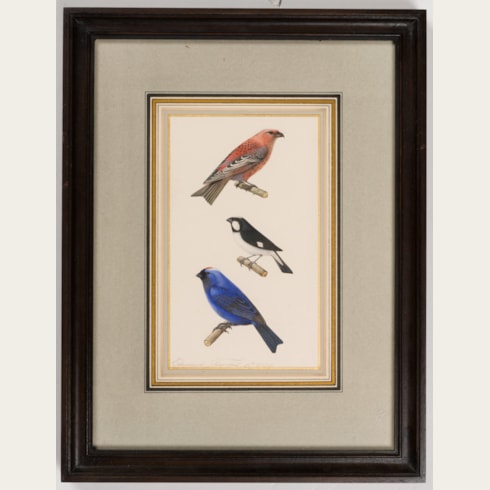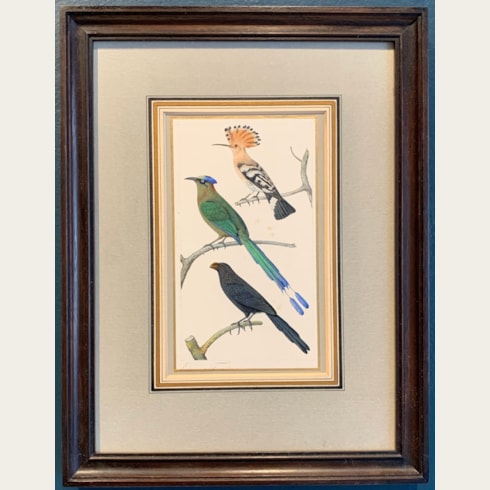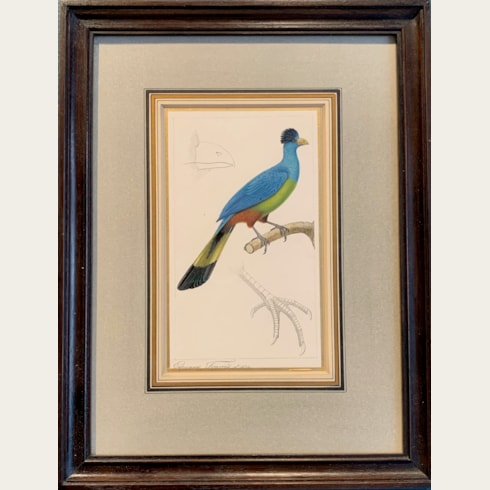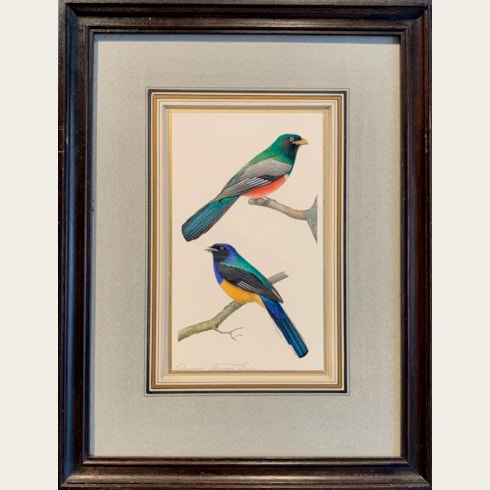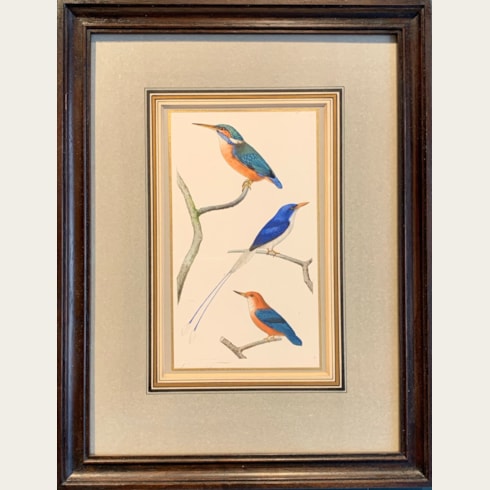Edouard TRAVIES
(Doullens 1809 - Paris 1876)
An African Emerald Cuckoo (Chrysococcyx cupreus) and a Citron-Throated or a Yellow-Throated Toucan (Ramphastos citreolaemus or Ramphastos ambiguous)
Sold
Watercolour, pen and brown ink and wash, with framing lines in pencil.
Signed and dated Edouard Travies pt. 1834. in the lower margin.
170 x 100 cm. (6 3/4 x 4 in.)
The African emerald cuckoo has a range that covers thirty-five countries across sub-Saharan Africa, including Angola, Botswana, Ethiopia, KwaZulu-Natal, Mozambique, Senegal, South Africa and Zimbabwe, amongst others. Interestingly, their preferred habitat differs across the continent; in Western Africa they can be found in lowland areas, while in the eastern part of the continent they inhabit forests at elevations of 2,000 to over 3,000 metres. The emerald cuckoo is a sexually dimorphic species - one in which males and females exhibit distinct characteristics from one another – as evidenced by their difference in plumage. Adult males have a vibrant emerald green head and back with a yellow belly, while adult females are duller with barred green and brown on their backs, and green on their breast. The present sheet depicts an adult male African emerald cuckoo. Easily identifiable by its call, a four-note whistle, the bird is known as the mooimeisie or ‘pretty girl’ in Afrikaans.
Previously identified as a citron-throated toucan, the toucan depicted in the present sheet is a bit of an anomaly. In some respects, it bears a closer resemblance to the yellow-throated toucan. For instance, the distinct bi-colour bill is far more similar to that of the yellow-throated toucan than to the citron-throated toucan, whose bill is predominately black with a bright blue and yellow line around the side and top. The colouring of the area around the eye is also a slight conundrum, since neither the citron-throated toucan nor the yellow-throated toucan have pink around their eyes. This therefore begs the question of whether the toucan depicted here by Traviès is a species which has since become extinct, as the artist’s overwhelmingly faithful drawings of birds would suggest that any artistic licence in this regard would be unlikely.
This drawing was once part of the truly exceptional collection of French ornithological watercolours of the 17th, 18th and 19th centuries assembled in the 1920s and 1930s by the French industrialist and bibliophile Marcel Jeanson (1885-1942).
Among the finest natural history draughtsmen of the 19th century in France, Edouard Traviès de Villers was a gifted watercolourist and illustrator, and exhibited at the Paris Salons between 1831 and 1866. Best known for his ornithological watercolours, his activity in this field culminated in seventy-nine magnificent illustrations for his book Les oiseaux les plus remarquables par leurs forms et leurs couleurs, published in Paris and London in 1857. Traviès also illustrated other works of natural history, such as Types du règne animal: Buffon en estampes; a work intended for children that appeared in 1864. Traviès was further known for his paintings and watercolours of dead game, depicted hanging from a nail on a wall in a sort of trompe-l’oeil effect; indeed, he was one of the first 19th century French artists to develop this theme, which had been established in the previous century by such artists as Jean-Baptiste Oudry.
These watercolours by Edouard Traviès were once part of the exceptional collection of French ornithological watercolours of the 17th, 18th and 19th centuries assembled in the 1920s and 1930s by the French industrialist and bibliophile Marcel Jeanson (1885-1942). Several of these watercolours were used to illustrate Achille Richard’s Oeuvres complètes de Buffon, published in Paris in 1834, 1838 and 1845.
Provenance
Marcel Jeanson, Paris
Thence by descent until 1988
Jeanson sale, Monaco, Sotheby’s, 16 June 1988
Richard J. Schwartz, Upper Nyack, New York and Lyford Cay, Bahamas
Thence by descent until 2017.







